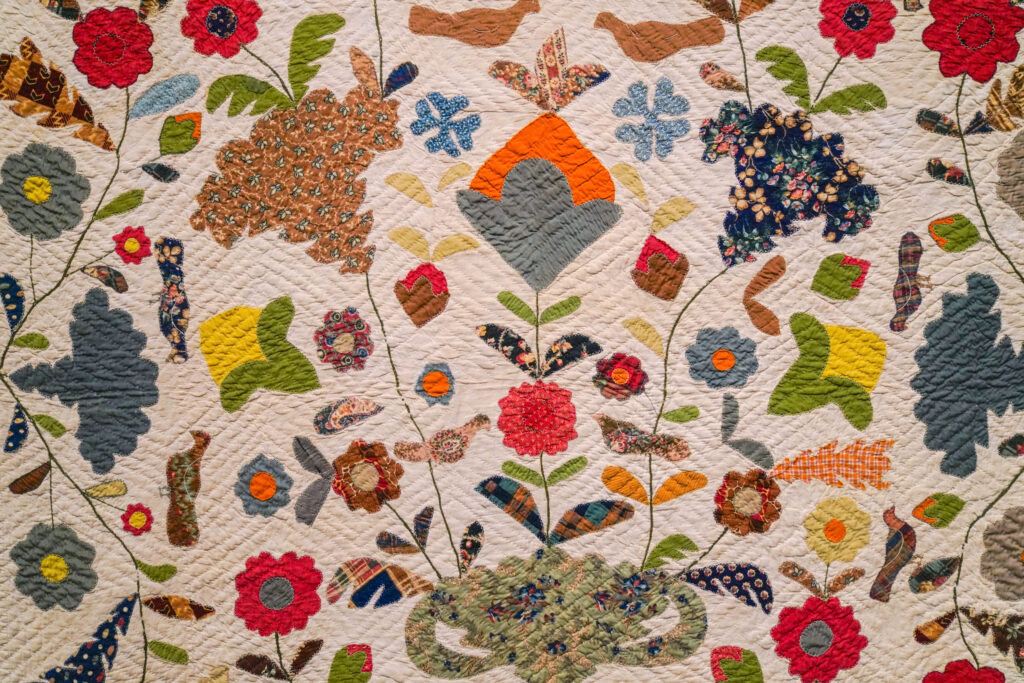
The art world is witnessing a significant resurgence in the appreciation of quilts, with numerous exhibitions dedicated to this traditional craft across the United States. In a statement reflecting on this trend, writer-historian Glenn Adamson declared 2024 as the year when “the art world went on a high fiber diet.” This year, art museums are showcasing the skills and creativity of quilting communities, highlighting quilts not just as functional items but as vital pieces of art.
One notable exhibition, titled **Routed West: Twentieth-Century African American Quilts in California**, is currently on display at the Berkeley Art Museum and Pacific Film Archive and will run through November 30, 2024. This exhibition delves into the historical significance of African American quilting traditions and their impact on contemporary art. Another significant showcase, **Of Salt and Spirit: Black Quilters in the American South**, can be seen at the Memphis Brooks Museum of Art until January 4, 2026.
The High Museum of Art in Atlanta is also contributing to this movement with the exhibition **Patterns in Abstraction: Black Quilts from the High’s Collection**. This exhibition features a selection of quilts crafted by Black women, emphasizing the rich narratives woven into each piece. Furthermore, the Frist Art Museum in Nashville is hosting **Fabric of a Nation: American Quilt Stories From the Museum of Fine Arts, Boston**, which explores the diverse histories represented through textiles.
Exhibitions Highlighting Nature and Industry
Among the exhibitions that stand out for their exploration of the connection between quilts and the natural world is **An Ecology of Quilts: The Natural History of American Textiles** at the American Folk Art Museum. Opened in late September 2023, this exhibition marks the museum’s reopening following renovations. It features a collection of 30 quilts from the 18th to 20th centuries, examining the interactions between nature, industry, and quilt making.
The exhibition opens with a striking display of whole-cloth quilts, including the **Cornucopia and Dots Whitework Quilt** from around 1800–1820. Visitors will find vibrant examples of quilts that utilize natural dyes, such as indigo and madder root. One section invites viewers to engage with the materials used in quilting, featuring silk cocoons and raw fibers, encouraging a tactile experience.
As visitors move through the exhibition, they encounter quilts that embody the beauty and symbolism of the natural world. The **Pot of Flowers Quilt with Birds** from around 1860 radiates joy with its colorful floral patterns. Another noteworthy piece, the **Flower Quilt** created by American sociologist Raymond F. Bellamy between 1955 and 1963, catalogues various flowers, showcasing the intersection of art and scientific observation.
Connecting Past and Present
The exhibition also features geometric quilts made from salvaged scraps, highlighting the themes of thrift and resourcefulness in quilt making. Among these is the **Pinwheel Variation Quilt** from 1960, crafted by Gee’s Bend quilter Malissia Pettway, and artist Tomie Nagano’s **Ajiro-Monyo** from 1995, made from vintage kimonos.
While the exhibition’s subtitle, *The Natural History of American Textiles*, suggests a comprehensive exploration, it presents a curated selection of topics ranging from global trade to the history of cotton cultivation. The display is not merely a static showcase; it invites deeper reflection on the connections between materials, technology, and human creativity, revealing the complex narratives embedded in each quilt.
In an era where the art of quilting is being reexamined, **An Ecology of Quilts** serves as a reminder of the enduring importance of this craft. It intertwines stories of nature, culture, and innovation, inviting visitors to appreciate quilts as not only artistic expressions but also as historical documents reflecting the lives and communities of those who created them.
The exhibition will remain open at the American Folk Art Museum until March 1, 2026, curated by Emelie Gevalt and Austin Losada. As museums across the country celebrate the artistry of quilts, they underscore the significance of this craft in American history and its relevance in contemporary art discussions.






